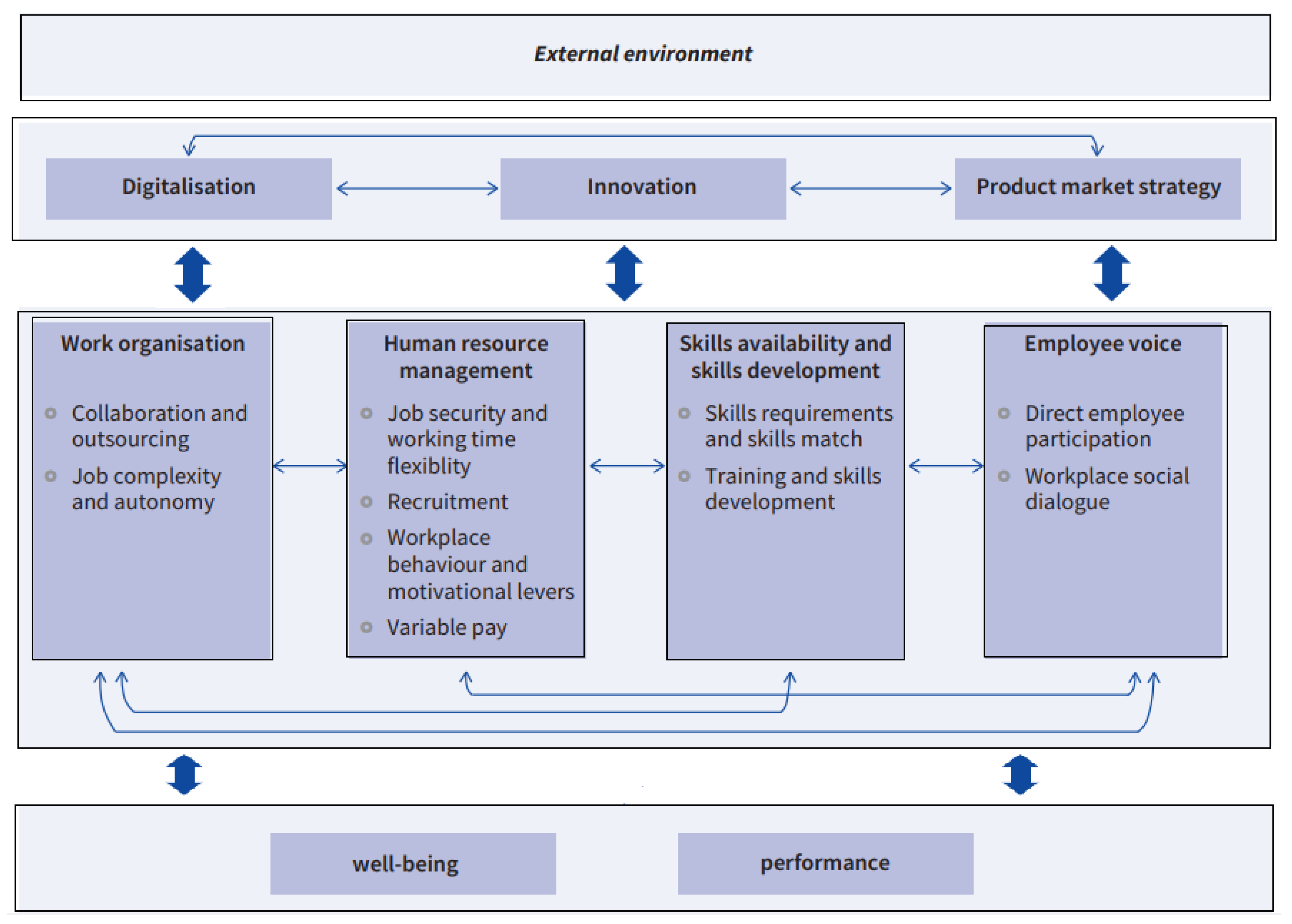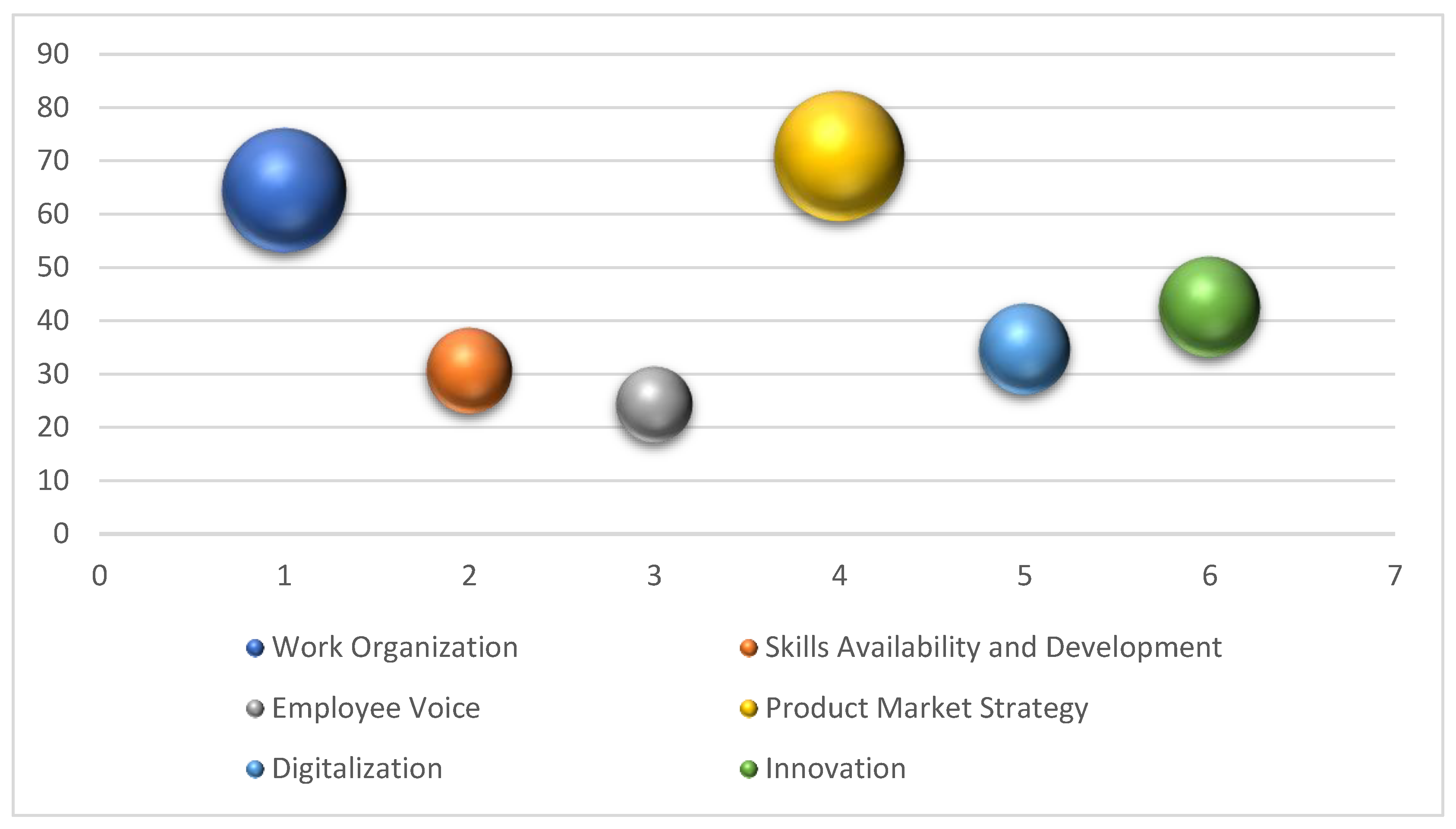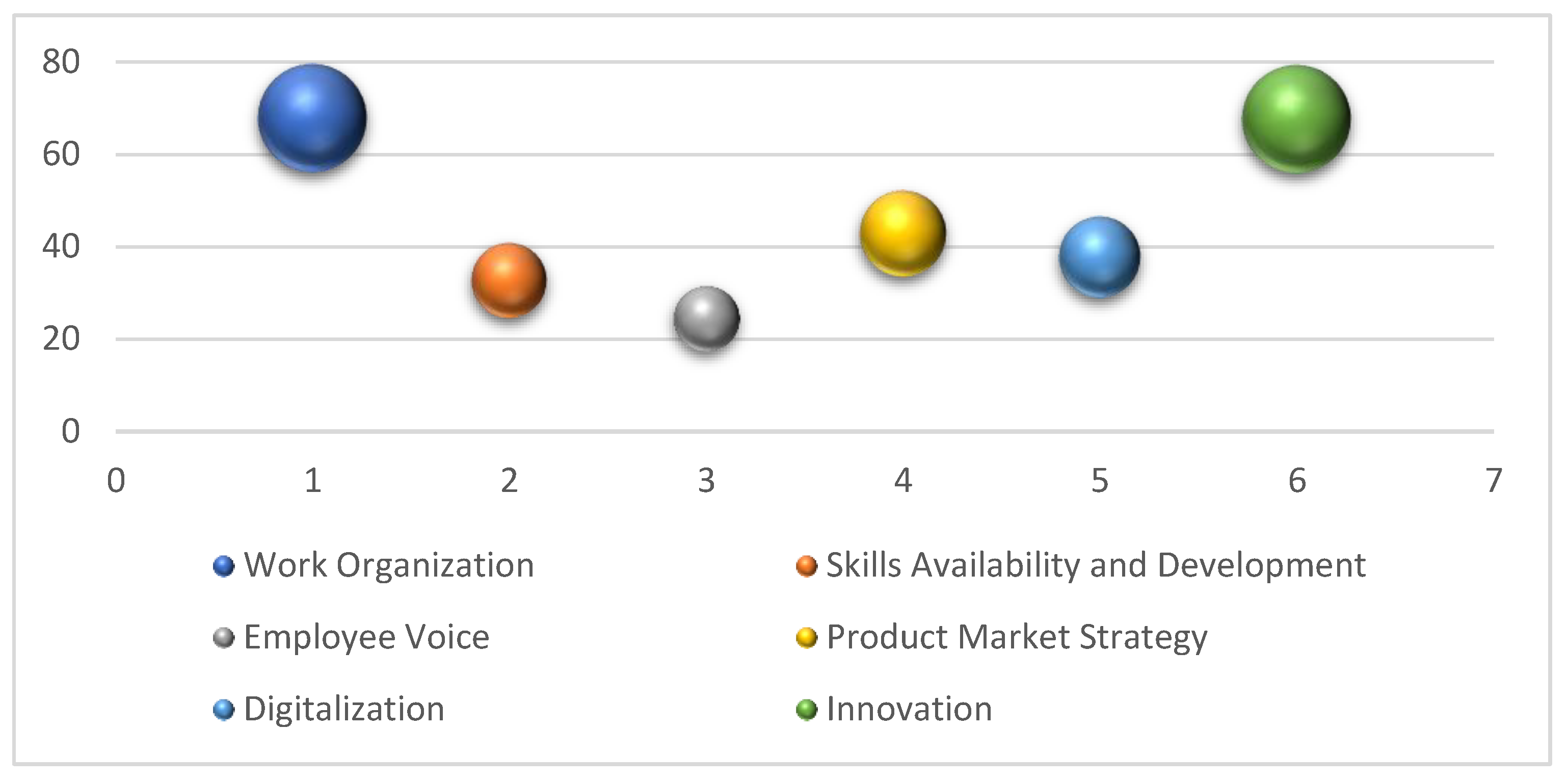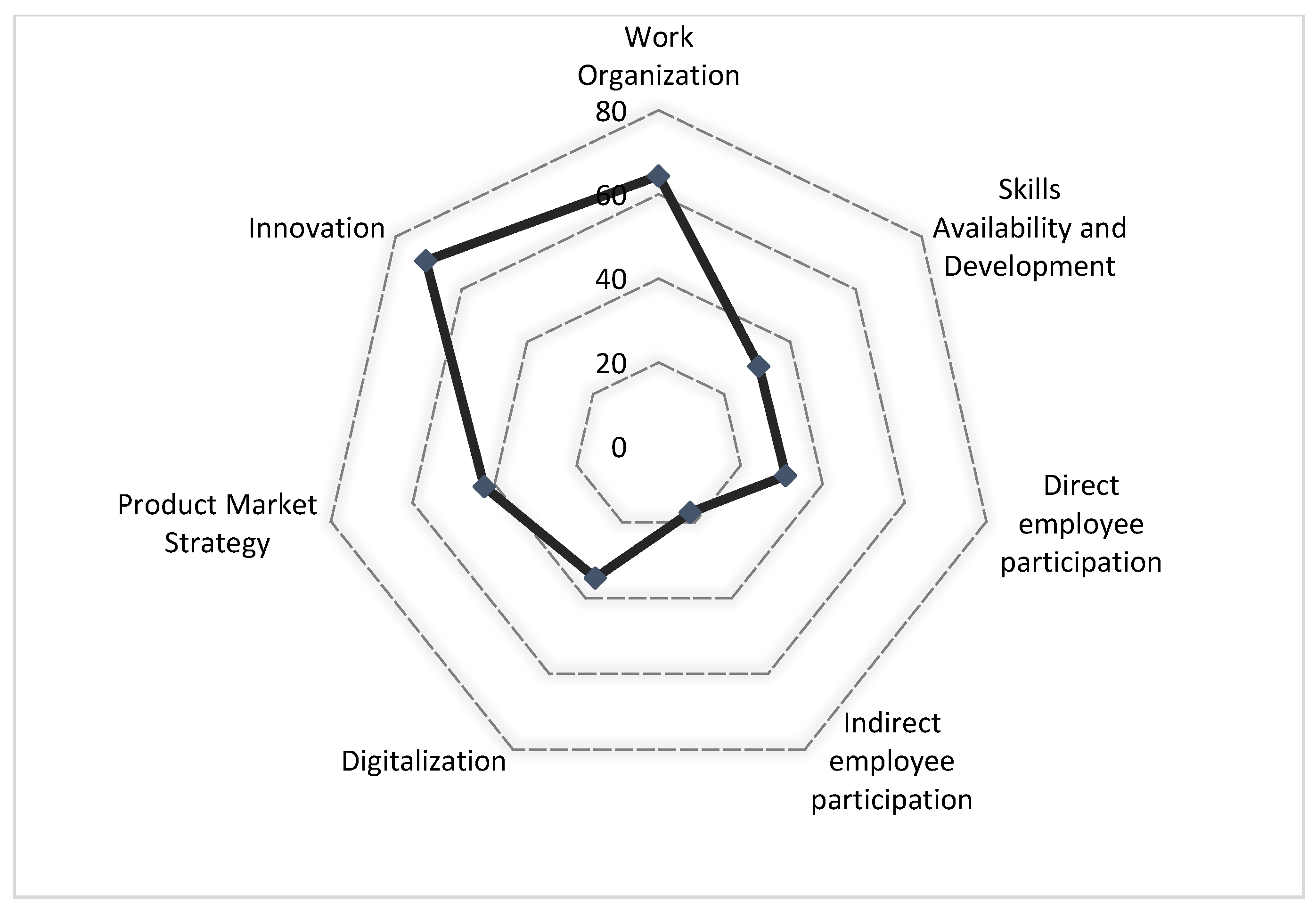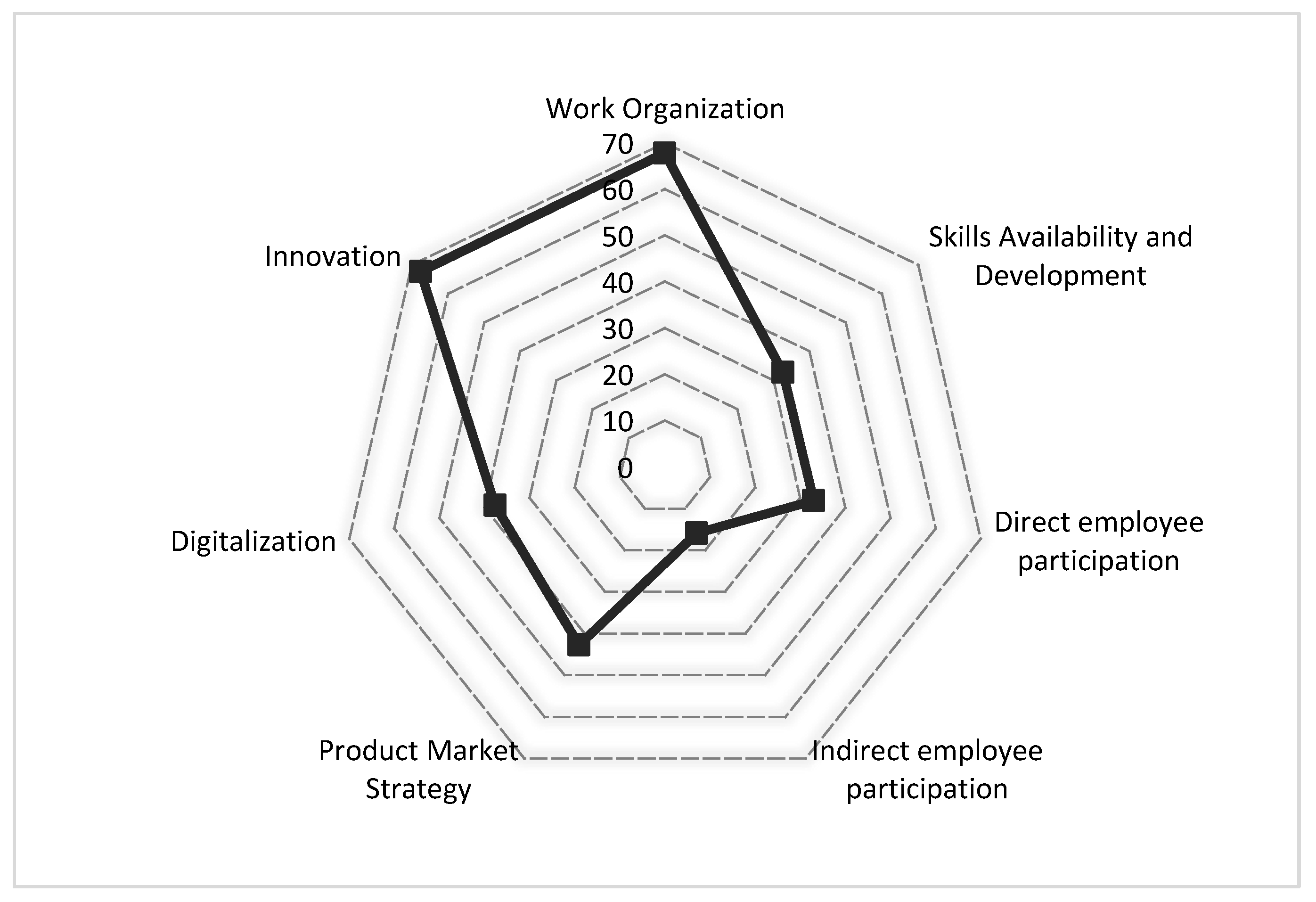1. Introduction
Organizational performance evaluation and quality improvement are essential for labor research and development [
1,
2,
3]. One of the tasks of a manager is monitoring organizational performance [
4,
5]. Organizational performance is a broad concept covering what a company produces or the services that it provides [
6,
7,
8]. In other words, organizational performance refers to how the mission, tasks, and organizational activities of the organization are carried out and in what quality [
9,
10]. Organizational performance evaluation is one of the issues that the business and academic communities have paid a lot of attention to, and numerous books and articles have been published on the subject [
11,
12,
13]. Performance evaluation is an effective measure and essential for resource management because not only does it ensure the organization’s mission is achieved with optimal performance, but also that the interests of employees and society are met [
14,
15,
16]. The need for organizational growth and employee excellence urges an effective evaluation system [
17,
18,
19]. Naturally, the development and implementation of such a performance assessment process would support organizations in achieving their goals by increasing the effectiveness of employees [
11,
20,
21,
22]. The literature suggests two approaches for performance assessment, i.e., subjective criteria approach and objective criteria evaluation approach [
23,
24,
25]. In the objective approach, the actual figures of the organization are used, but in the subjective approach, the perceived responsiveness is used [
26]. Ramstad [
27] concludes that a subjective indicator of productivity is essential for measuring productivity for a comparative analysis of different organizations and for producing results with better applicability. There is evidence in the literature that managerial factors are one of the factors influencing the performance of a firm [
28]. Managerial factors identify how managers define the organization’s ideals and mission and facilitate access to them, create the values needed for long-term success, and apply them through appropriate activity and behavior. These factors can directly or indirectly affect the performance and the working practice of companies [
29]. Human resources are another factor whose impact on the performance of firms has been studied and confirmed [
30,
31].
It had been well studied that relentless market competition, quality, price and speed are three competitive advantages [
32,
33]. One of the most important factors for entering global markets and developing an economy is to make employees efficient in the production and service sectors [
34]. Therefore, many organizations choose a culture of commanding and monitoring and move towards improving innovation culture [
35]. Furthermore, organizational structure has a significant effect on improving the performance of firms [
36]. Thus, to improve organizational performance, it is necessary to synchronize it with employee well-being [
37,
38]. For instance, the Finnish Workplace Development Program (TYKES) (2009–2010) empirically supported the interplay between high-involvement innovation practices (HIIPs) and simultaneous improvement of productivity and the quality of working life (QWL) [
27]. Information technology is another factor that has a significant effect on improving the performance of enterprises. Today, the trend of change in organizations is so great that instability can be called the most stable feature of organizations, because, with the growth of the World Wide Web and affiliate communication technology, many companies are small- and medium-sized. Based on the Organization for Economic Co-operation and Development (OECD) definition, information and communication technology (ICT) is a set of manufacturing and service industries used to store, transmit, and display data and information electronically [
29]. ICT includes factors such as the extent of ICT spread in the organization [
39], the rate of information technology updates [
40], revenue from the use of technology, and the ability to trade through information technology with customers and suppliers [
41,
42].
The current study uses the ECS (2019) [
43] conceptual framework for evaluating the firm performance. The model, similarly to [
43,
44,
45], has two outputs, i.e., firm performance and employee well-being. According to this model, two levels of variables affect these outputs: (1) organizational characteristics and (2) external environment. Organizational characteristics include work organization, skill availability and skill development, and employee voice, as also described in [
46,
47]. Accordingly, the influential variables of the external environment include digitalization, innovation, and product market strategy. At a lower level, “collaboration and outsourcing” and “Job complexity and autonomy” are the variables that evaluate the work organization. In order to assess skill availability and skill development, the variables of “skills requirements and skills match” and “training and skills development” are used. Finally, “direct employee participation” and “workplace social dialogue” (i.e., indirect participation) are used to measure employee voice. In the context of the COVID-19 pandemic, research on new models of work and employment accelerated [
48]. Beside remote working and digital platform work, topics such as “Navigating post-COVID workplace innovation evolution: Exploring flexible working models, investing in reskilling and well-being and evaluating new policy trends” are advertised by the scholars of the European Workplace Innovation Network (EUWIN), reflecting the intensified search for new models of work and management practices [
49]. In order to assess the originality of these attempts it is worth remembering the former attempts to search for a universal model to renew working practices. For several decades, the academic community, especially scholars of human resource management (HRM), have been stressing the relationship between working practices—especially workplace innovation generating workplace practices—and company-/firm-level productivity (Dortmund/Brussels Position Paper, 2012). The “benchmark”-labeled workplace practices were labeled as the High-Performance Working Practice (HPWP) or High-Performance Working System (HPWS) [
45,
46,
47]. This type of working practice was characterized by job/task structure giving autonomy and requiring problem-solving, allowing the autonomy of workers, involving them in decision making (direct participation), etc. Companies adopting workplace innovation-generating HPWP/HPWS practice in the US produced significant performance increase (Appelbaum, 2015). Until the last decade – with the exception of the Nordic countries—there were no attempts to explore the roles of factors influencing not only organizational (firm) performance but employees’ well-being too [
27]. This paper intends to identify the links between the factors shaping a firm’s performance and employees’ well-being through evaluating human resource managers’ perceptions in the EU. The latest European Establishment Survey (2019), covering the EU-27 countries and the U.K., represents a unique possibility to empirically test these links [
43]. In the literature, performance evaluation refers to the way missions, tasks and organizational activities are performed. The complex process of the measurement and evaluation of the performance in the forms of efficiency and effectiveness in achieving the of organizational goals fo structural and long-term development is known as firm performance evaluation [
50,
51]. The performance evaluation has been seen as a controversial management tool in search for the answers to common system design and management problems [
52]. Firm performance evaluation evaluates the work completed in terms of quality, quantity, and method of completion during a certain period of time in comparison with the standards.
Considering the trade-off between a firm’s performance and employee well-being, the European Company Survey (ECS) 2019 focused on workplaces, and the research concluded that in order to obtain reliable results, what works for employers must also work for workers. Working practices must result in win–win situations. In other words, socially optimal dissemination of the outcomes makes social and economy transaction easier [
52]. The ECS 2019 sheds light on how organizations inspire and engage their employees, and whether these strategies maximize employee potential, including formal and implicit skills. In addition, it provides information on an individual’s ability to improve performance in the workplace. Successful approaches in this area turn abstract concepts such as human capital into tangible competitive advantages. In other words, as [
27] expresses, a strong link between highly engaged innovation practices and simulation productivity and quality benefits both employers and employees. In this regard, novel data-driven models are essential to provide insight into the relationship between input and output variables. Currently, there is a research gap in applying machine learning methods to deliver a model with higher accuracy and performance. In this study, an ensemble machine learning method is accordingly proposed.
2. Background
The literature identifies several links between the innovation, well-being, productivity, quality and firm performance [
27]. The ECS 2019 topics include complex work relationships. For example, despite the fact that the European workforce benefits from a high level of education, companies are often facing difficulty in finding skilled workers. A lack of trust can cause management initiatives to fail [
53]. For instance, in a work environment where trust is low, employees may be reluctant to share ideas and tacit knowledge about how to improve work processes [
54]. Tackling these challenges requires understanding what companies do with the talent and knowledge their employees possess, how they manage employee hiring, and how they attract people inside and outside of the organization’s decisions [
55]. Of course, how companies use and develop their employees’ talents, as well as how they harness and respond to employee voices, must be understood in the broader context of organizational culture, job choice, organizational culture, technology and competitive performance in the product market. In this approach, management pursues knowledge efficiency rather than cost efficiency [
56]. The foundation of the current European survey is based on the theoretical framework of strategic human resource management. It develops the concept of innovation in the workplace by linking investment in human resources, participatory work organization, and employee engagement directly and indirectly with measures of performance and company welfare. Under the appropriate conditions, firms profit from investing in human resource systems that promote employee well-being [
57]. Indeed, investing in employee well-being helps to ensure the employment relationship is managed well. The employment connection between a company and its workers includes reciprocal beliefs, perceptions, expectations, and informal duties. It incorporates the labor contract, which describes in detail only the most obvious conditions of the exchange of work for money, while mutual duties are defined in very broad terms [
58]. Employees and organizations have both complementary and diametrically opposed goals. The labor contract is sufficiently specific to give direction on resolving a limited number of circumstances when interests disagree. Divergent interests must be handled in the remaining circumstances via the continuous link formed by the job relationship, in other words, through a relational contract [
59]. Managing divergent interests using relational contracts is contingent upon the parties’ ability to exchange [
60]. These exchanges may take on a variety of forms and occur at a variety of periods, as workers develop connections with a variety of individuals, for instance, human resources managers, line managers and supervisors, as well as colleagues and team members—and with the company as a whole [
54]. The feedback form at the heart of this report is the form in which organizations invest in their employees by implementing workplace practices that improve employee well-being, and employees respond by demonstrating attitudes, motivations, and behaviors conducive to business performance [
61]. Proposing advanced data-driven modeling, e.g., [
62,
63,
64,
65], to bring insight into the work organization, innovation, and performance of an employer for better understanding the involved variables. The application of artificial intelligence and machine learning in modeling the complex relationship of such variables has been limited, however [
66,
67,
68,
69]. Consequently, in this research, the application of one of the essential machine learning algorithms for modeling organizational performance and well-being is evaluated.
5. Conclusions
Achieving the goals of an organization depends on the ability of human resources to perform the assigned goals. Human resource is often regarded as a critical aspect in achieving organizational objectives and enhancing their efficiency. Thus, enhancing both performance and employees’ well-being at the same time is an unavoidable need for sustainable businesses’ success too. Consequently, the present study identifies the factors affecting the formation of firm performance and employee well-being and ranks them based on their importance. For this purpose, the theoretical framework and the dataset of the ECS 2019 were used to propose a novel model based on machine learning. Findings from the genetic algorithm and BART machine learning model disclosed that work organization and innovation are the most important variables in enhancing both firm performance and increasing employee well-being. In other words, this study shows that the influence of an employee’s talents in boosting the performance of the firm is smaller than the impact of cooperation with business partners. Companies that outsource more tasks have reported improved employee well-being as well. This means that in the firms whose structure is more adaptable to working with other partners, their employees report better levels of satisfaction and motivation.
Furthermore, among the external environmental elements, it was revealed that innovation is the one that has had the largest influence on both organizational success and employee well-being. This research demonstrates that the firms who have established methods to exploit innovation have both reported superior organizational performance and their employees have exhibited more willingness to work in such contexts. Thus, it is suggested that organizations, in order to increase their performance, on the one hand, pay more attention to collaboration and outsourcing, as well as job complexity and autonomy, and on the other hand, provide an environment for producing and implementing innovation in organizations.
